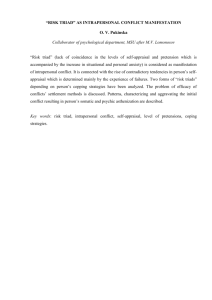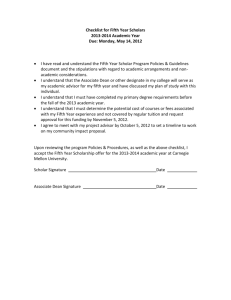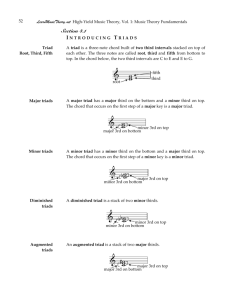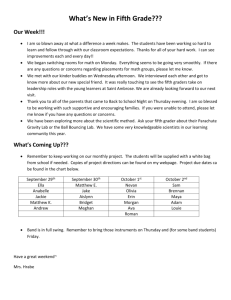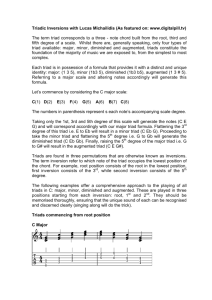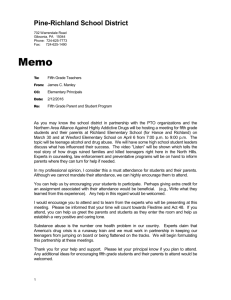Introduction to Chords A chord is a combination of three or more
advertisement
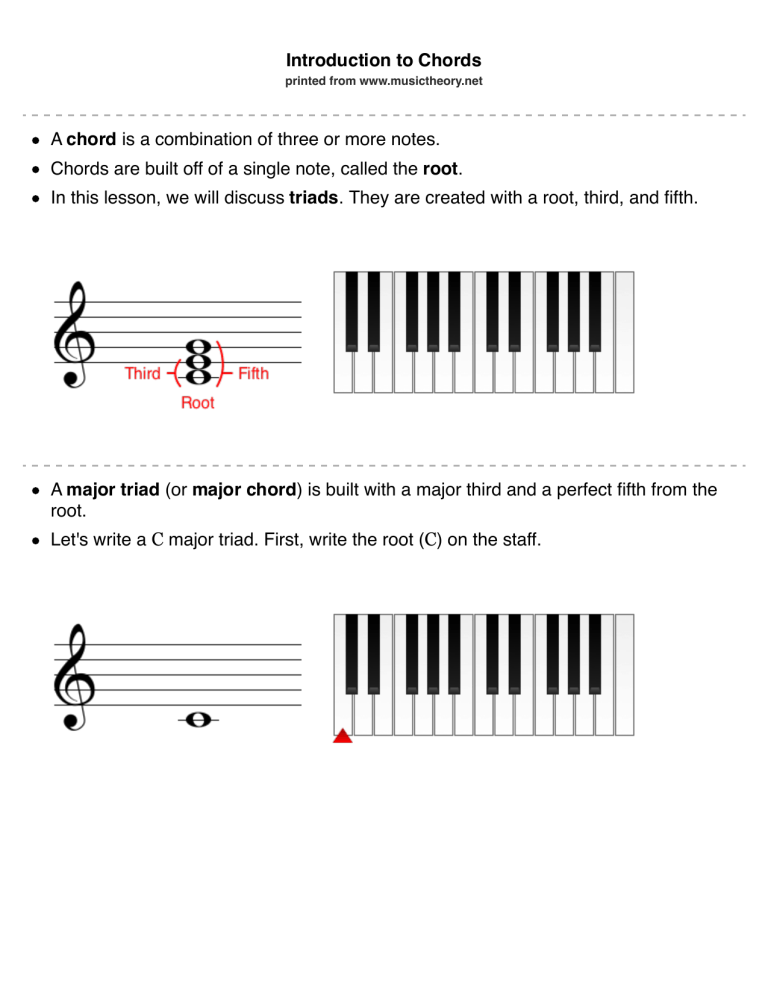
Introduction to Chords printed from www.musictheory.net A chord is a combination of three or more notes. Chords are built off of a single note, called the root. In this lesson, we will discuss triads. They are created with a root, third, and fifth. A major triad (or major chord) is built with a major third and a perfect fifth from the root. Let's write a C major triad. First, write the root (C) on the staff. Next, write the generic third and generic fifth from the root. We now need to determine the specific intervals on the keyboard. Since we need a major third, let's count up four half steps from the root. For the perfect fifth, go back to the root and count up seven half steps. Since the chord contains no black keys, we do not need to write any accidentals on the staff. A C major triad is C—E—G. Next, let's try an Eb major triad. Write the generic third and fifth on the staff. Now, switch to the keyboard. Start at the Eb and count up four half steps for the major third. Go back to the root and count up seven half steps for the perfect fifth. Finally, write any needed accidentals. In addition to the already-written Eb, we need a flat next to the B. An Eb major triad is Eb—G—Bb. Next, let's try a B major triad. Write the generic third and fifth on the staff. Count the major third (4 half steps) and perfect fifth (7 half steps). Finally, write the needed accidentals on the staff. We need two sharps: one for the D and one for the F. A B major triad is B—D#—F#. Next, we will discuss the minor triad. It is created with a minor third and a perfect fifth from the root. Let's build a C minor triad. Write the generic third and fifth on the staff. Now, switch to the keyboard. Start at the C and count up three half steps for the minor third. Go back to the root and count up seven half steps for the perfect fifth. Finally, write any needed accidentals. A C minor triad is C—Eb—G. Let's build an Eb minor triad. Write the generic third and fifth on the staff. Next, count the minor third (3 half steps) and perfect fifth (half steps). Finally, write any needed accidentals. An Eb minor triad is Eb—Gb—Bb. Let's build a B minor triad. Write the generic third and fifth on the staff. Next, count the minor third (3 half steps) and perfect fifth (7 half steps). Finally, write any needed accidentals. A B minor triad is B—D—F#. The augmented triad is built with a major third and an augmented fifth. Let's build a C augmented triad. Write the generic third and fifth on the staff. Now, switch to the keyboard. Start at the C and count up four half steps for the major third. Go back to the root and count up eight half steps for the augmented fifth. Finally, write any needed accidentals. A C augmented triad is C—E—G#. Let's build an Eb augmented triad. Write the generic third and fifth on the staff. Next, count the major third (4 half steps) and augmented fifth (8 half steps). Finally, write any needed accidentals. In this example, no additional accidentals are needed. An Eb augmented triad is Eb—G—B. Let's build an B augmented triad. Write the generic third and fifth on the staff. Next, count the major third (4 half steps) and augmented fifth (8 half steps). Finally, write any needed accidentals. A B augmented triad is B—D#—Fx. The last triad that we will discuss is the diminished triad. It is built with a minor third and a diminished fifth. Let's build a C diminished triad. Write the generic third and fifth on the staff. Now, switch to the keyboard. Start at the C and count up three half steps for the minor third. Go back to the root and count up six half steps for the diminished fifth. Finally, write any needed accidentals. A C diminished triad is C—Eb—Gb. Let's build an Eb diminished triad. Write the generic third and fifth on the staff. Next, count the minor third (3 half steps) and diminished fifth (6 half steps). Finally, write any needed accidentals. An Eb diminished triad is Eb—Gb—Bbb. Next, let's build a B diminished triad. Write down the root and generic intervals. Write the generic third and fifth on the staff. Next, count the minor third (3 half steps) and diminished fifth (6 half steps). Finally, write any needed accidentals. No accidentals are needed. A B diminished triad is B—D—F. Use this chart to reference the four types of triads. If this lesson helps you, please purchase our apps or donate.
